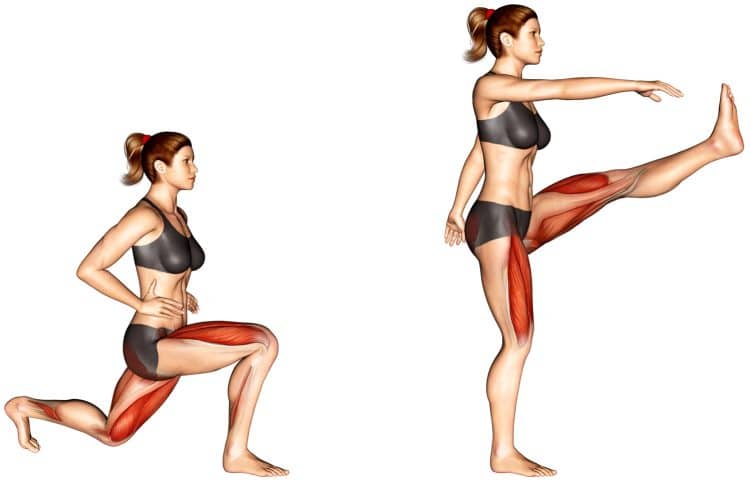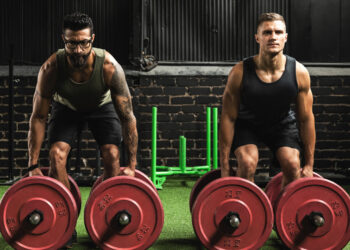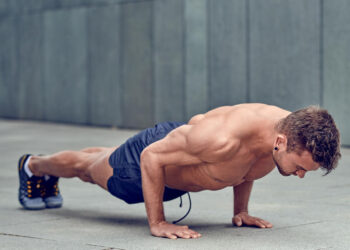You don’t need to be a martial arts enthusiast to try the reverse lunge (leg kick) but if you need more action in your leg workouts, well, this would be a great way to do it. The idea of including a front kick is to get some extra quad flex in the non-working leg during bodyweight lunges and possibly the greatest benefit is a better mind-muscle connection and functional training. Additionally, reverse lunges are easier on the knees which means they’re generally a better option for heavier people and those who usually experience knee pains.
Check out our full reverse lunge (leg kick) workout guide below for in-depth instruction, benefits, variations and alternatives, programming and optimal loading tips.
How To Do The Reverse Lunge (Leg kick)
A bit more complex in execution compared to the standard reverse lunge, incorporating a front kick means you need to be more focused to get the best outcome. Otherwise, you’re wasting a perfectly good technique.
Below are in-depth step-by-step instructions to help you perform reverse lunges with a front kick the right way.
Note: Before attempting the reverse lunge (leg kick), we highly recommend that you do a few minutes of light activity such as other lower body exercises, high steps, or even a short mobility workout to warmup your hips and other muscles groups.
Step 1: The setup
- Stand with your feet spread roughly hip width apart, toes pointed straight forward, and arms bent at a 90-degree angle for balance.
Step 2: Pre rep preparation
- Before you drop down into the split squat, you want to brace your core muscles to stabilize your spine and protect your lower back. Try to maintain a rigid midsection and only relax when you return to the standing position between each repetition.
Step 3: Split squat
- Bend slightly at the hips, bend your knees and drop your butt down to the floor as you take a step back with either foot a few feet behind your body. Descend into a squat until your front leg is just below or right at parallel to the ground. Try to keep the knee of your front leg from moving too far forward over your feet. Although it’s not a big deal if you have healthy knees.
Tip: Avoid letting the knee of your back leg slam into the ground as it can be painful or cause your knee to be messed up for a while.
Level Up Your Fitness: Join our 💪 strong community in Fitness Volt Newsletter. Get daily inspiration, expert-backed workouts, nutrition tips, the latest in strength sports, and the support you need to reach your goals. Subscribe for free!
Step 4: Reverse lunge into leg kick
- Drive the foot of your front leg into the ground and stand up out of the squat. As you transition back to the standing position, simultaneously bring the rear knee up in front of you at roughly hip height then extend your foot forward and kick your toes forward at hip height or higher if you can do so safely.
Step 5: Repeat with the same leg
- Bring your extended leg (kicking leg) back behind your body into the lunge position. Do not reset your feet to the hip width starting position. You want to transition directly into the lunge and repeat until you’ve completed one set.
Step 6: Switch legs and repeat
- Don’t forget to switch legs and follow steps one through five.
Pro tip: Your level of hip mobility and flexibility will determine the height of your kick. Don’t be discouraged if you cannot go that high and don’t force it as you can pull a muscle.
Check a detailed video demonstration of the reverse lunge (leg kick) below.
Benefits
Lunges are truly a must-have for lower body training. These are reasons why you might want to consider this variation in your training.
A nice ass
Nothing is worth than the old pancake butt or one that resembles a double door fridge. In our opinion, few exercises can beat lunges for butt training and you’ll know because of how sore the are after a workout.
[Related: Best Butts on the Internet]
Build the quad teardrop
Lunges are also one of the best quad-building exercises that you can do to build the highly-sought after teardrop shape on the lower quads near the kneecap. Driving through your feet up and out of the squat position of the lunge requires heavy involvement of these muscles and we recommend adding weight for even better results.
While the front leg benefits the most during lunges, the leg kick variation also helps to stimulate more of the rear leg as the knee extends and contracts the quads during the front kick.
Develop coordination and balance
Lunges can be difficult on their own because they require balance and you’ll know if you’ve done them. Well, adding a leg kick will make it even more challenging. Especially because for this variation, you won’t be resetting before each repetition. You have to drop right back down into the lunge position before each rep.
Drawbacks
There are a few drawbacks of the reverse lunge (leg kick) however, it’s still a fantastic leg exercise that most people can benefit from.
Requires flexibility and mobility
Unless you can lift your legs to roughly hip height, you’re probably wasting your time because the exercise doesn’t seem to be as effective if you’re just doing a low kick. We recommend working on your hip mobility and staying flexible and mobile overall.
Variations and Alternatives
The reverse lunge and its variations should be a staple in your lower body training regime because it really is that effective and one of our top exercise choices. Check out these variations in addition to a few alternatives that we recommend.
Level Up Your Fitness: Join our 💪 strong community in Fitness Volt Newsletter. Get daily inspiration, expert-backed workouts, nutrition tips, the latest in strength sports, and the support you need to reach your goals. Subscribe for free!
1. Reverse lunge high step
Here’s an idea if you cannot perform a full front kick out of the reverse lunge, do a high step instead. You still need a basic level of lower boy mobility but this is a good progression if you’re not quite ready for the front kick.
2. Reverse lunge (kickback)
While lunges are a glute heavy exercise all on their own you can add a rear kick to activate the butt muscles a little more.
To do it:
- Drop down into a reverse lunge.
- Stand up from the lunge and immediately kick your leg up behind you squeezing your glutes at the same time.
- Reset your feet back to the hip width starting position and repeat for the ideal number of reps.
Don’t forget to switch legs and do the other side.
3. Forward lunge
The forward lunge might be the most common variation and some people prefer it. Although it’s commonly believed that the reverse lunge is better for the knees because the step forward may create more impact on the joints. Forward lunging is also more versatile (e.g., walking lunging), and arguably better when you want to add weight as it feels more natural.
Related: The Ultimate Guide to Lunges: Muscles Worked, Benefits, How-to, and Variations
4. Seated machine leg extension
We can’t think of a better alternative to the reverse lunge (leg kick) than leg extensions. Why? Because you’re simulating a movement similar to the kick but with resistance. This is a much better muscle building alternative but the drawback is you need a dedicated machine.
Programming Reverse Lunges (leg kick) In Your Training Regime
This is where things get exciting because now you get to program the reverse lunge (leg kick into your workouts) and it’s a snazzy way to add a little flavor (or shall we say kick) to your lower body routine.
Of course, there are so many options for including this movement in your training and we couldn’t possibly go over them all. But we did drop an example leg workout routine below so you can get an idea of how to incorporate reverse lunges.
Example leg workout
- Squats: 3 sets x 12-15 reps
- Reverse lunge (leg kick): 2 sets x 15 reps
- Hamstring leg curls: 3 sets x 10-12 reps
We also recommend switching out reverse lunges (leg kick) with some of the other effective leg variations that we included above.
Sets and Reps Range
Bodyweight exercises are not as straightforward when it comes to determining ideal rep ranges. That’s because your body is the weight and it remains constant. Although you can shift your weight using various angles but not so much in this case.
If lunges become too easy for you, add weight by holding dumbbell, barbell, a weighted vest or whatever works best for you.
The ideal range for muscle growth is 6-20 reps for lower body muscles. So try to remain within this range and you’ll be good to go!
Muscles Worked

- Gluteus Maximus – A very large muscle, the gluteus maximus belongs to the buttocks family. Its main role is to extend and externally rotate the thighs but it’s also a postural and performance muscle.
- Quadriceps – If you want nice legs, then you must focus on building your quadriceps or quads. Its four heads – rectus femoris, vastus lateralis, vastus medialis, and vastus intermedialis contribute to hip flexion and knee extension.
- Hamstring – Making up most of the upper rear leg mass, hamstrings share the thigh with quads muscles consisting of a semitendinosus, semimembranosus, and biceps femoris. Opposite of the quads function hamstrings extend the hips and flex the knees. An interesting fact about the hamstrings is the short head of the biceps femoris only crosses the knee joint.
- Adductor magnus – The adductor magnus is the king of adductors. Supposedly the largest adductor group and the most powerful and complex, magnus is located in the posterior and medial fascial compartments of the thigh. It’s main role is to help the adductors move the thigh inward. But the adductors also work together to flex, extend, internally and externally rotate the thighs, and stabilize the pelvis during the gait cycle. Magnus has muscle fibers on the from and back of the thigh meaning it can perform function on both sides.
- Calves – The calves are an explosive muscle group consisting of two primary heads – gastrocnemius and soleus. The point the toes toward the ground.
Bottom Line
If you want to emphasize your quads a little more during lunges the front leg kick variation is an interesting way to do it. The benefit comes not from overloading the muscles with a lot of weight but rather emphasizing full knee extension and muscle contraction which could help to improve your mind-muscle connection which may be an important factor in muscle building.
Interested in measuring your progress? Check out our strength standards for Lying Leg Curl, Leg Extension, Reverse Lunge, and more.








